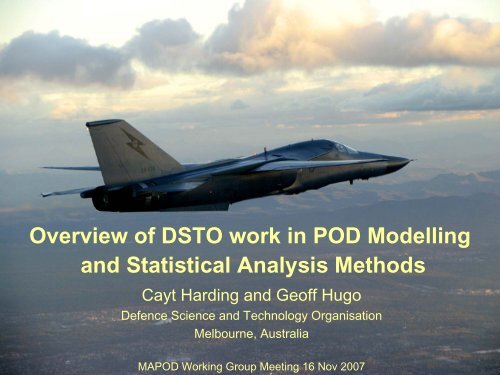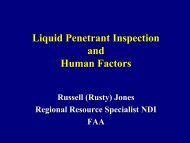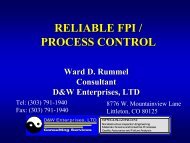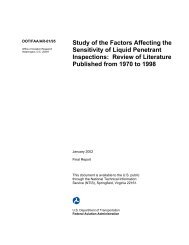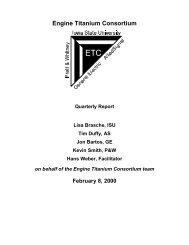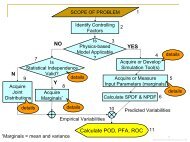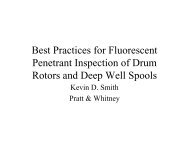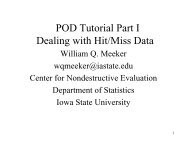DSTO, Australia
DSTO, Australia
DSTO, Australia
You also want an ePaper? Increase the reach of your titles
YUMPU automatically turns print PDFs into web optimized ePapers that Google loves.
Overview of <strong>DSTO</strong> work in POD Modelling<br />
and Statistical Analysis Methods<br />
Cayt Harding and Geoff Hugo<br />
Defence Science and Technology Organisation<br />
Melbourne, <strong>Australia</strong><br />
MAPOD Working Group Meeting 16 Nov 2007
MAPOD for Inspection of Lower Wing Skin<br />
Fastener Holes<br />
Automated ultrasonic C-scan inspection for cracks at fastener holes<br />
• Full A-scan data capture and technician review of stored data<br />
MAPOD approach outlined at April MAPOD WG meeting<br />
• Transfer function approach<br />
• Refer to JCAA 2007 paper (Harding, Hugo and Bowles)<br />
Progress<br />
• Data obtained from field POD trials<br />
(previously reported results were for laboratory data)<br />
• Modelled human factors inherent in operator recognition of crack<br />
indications within C-scan data
Transfer Function Modelling Response for<br />
Cracks in Wings<br />
Assume ultrasonic response for defect of size a follows:<br />
log( r)<br />
= β0<br />
+ β1<br />
log( a)<br />
+ ε<br />
d<br />
ε →<br />
N(0,<br />
δ )<br />
Transfer function for predicted response from cracks in wings:<br />
β<br />
β<br />
δ<br />
0, CW<br />
1, CW<br />
2<br />
CW<br />
=<br />
=<br />
β<br />
β<br />
= δ<br />
0, CS<br />
1, CS<br />
2<br />
CS<br />
+ β<br />
+ β<br />
+ δ<br />
0, EW<br />
1, EW<br />
2<br />
EW<br />
− β<br />
−δ<br />
− β<br />
1, ES<br />
2<br />
ES<br />
0, ES<br />
ES – EDM in specimens<br />
EW – EDM in wings<br />
CS – cracks in specimens<br />
CW – cracks in wings
Modelled POD for Mid-bore Cracks<br />
Mid-bore<br />
crack<br />
ES – EDM notches in specimens<br />
EW – EDM notches in wings<br />
CS – cracks in specimens<br />
CW – cracks in wings (predicted)
Incorporation of Human Factors<br />
Modelled effect of human factors through a variable<br />
threshold, r th , for detection
Inspection of a Fatigue Test Wing<br />
Under Load<br />
Full-scale fatigue-test wing inspected with automated UT<br />
system at completion of fatiguing<br />
• Wing loaded during UT inspection to open any cracks present<br />
in lower skin<br />
• Smaller cracks detected clearly only with load applied<br />
• Larger cracks detected by UT equally well without load<br />
• Waiting on fractography to confirm actual crack size<br />
Results for genuine fatigue cracks in full-scale test wing confirm<br />
previous results for cracks in laboratory specimens
Statistical Analysis of POD Data<br />
<strong>DSTO</strong> has conducted large-scale simulations to test analysis<br />
methods for hit-miss POD data<br />
• Selected numbers of hit-miss observations per data set<br />
(between 40 and 2000 data points)<br />
• Up to 5000 simulated data sets for each data set size<br />
• Compare distributions of fitted a 50 , a 90 and a 90/95 values<br />
• Compare incidence of lower confidence limits which are<br />
non-conservative relative to assumed true POD curve<br />
• Whole curve and single percentile CL’s examined<br />
Observed significant differences between different analysis<br />
methods, especially for confidence limits<br />
• Some methods gave non-conservative rates >> 5% for (supposedly)<br />
lower 95% confidence limits
POD Data Analysis Benchmarking<br />
Exercise<br />
Proposal: <strong>DSTO</strong> would like to participate in a limited exchange of<br />
simulated data sets to compare the statistical analysis methods in<br />
use by different practitioners<br />
• Each participant runs data sets through their preferred implementation of the<br />
statistical analysis<br />
• Two possible exercises<br />
- Small number of interesting data sets, and/or<br />
- Large number of simulated data sets for a comprehensive assessment<br />
• Establish the consistency (or otherwise!) of different implementations of the<br />
analysis methods<br />
We would volunteer to provide simulated hit/miss data sets to<br />
interested parties and then compile the results for the next MAPOD<br />
WG meeting<br />
• Details to be negotiated off-line if there is interest<br />
• We are also interested in a similar exercise for â vs a data, if someone else<br />
were able to lead it (i.e. provide the data sets)


